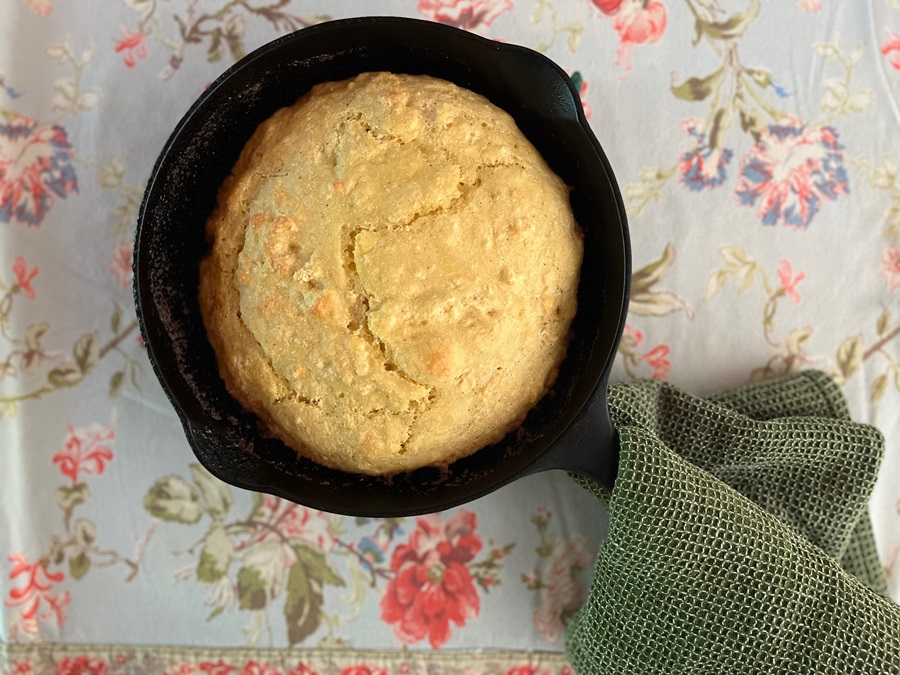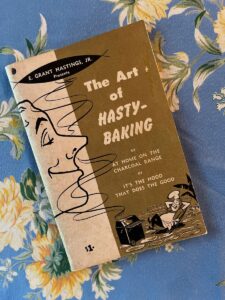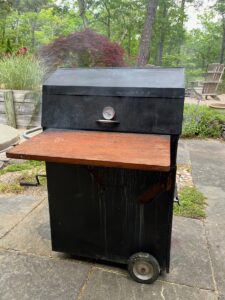One thing my dad has learned since moving to Cape Cod from Hot Springs, Ark. is that the main difference between people here and the people he really relates to is the way they understand cornbread.
“They keep giving us this cornbread that’s like cake,” he tells me, like he’s reporting a crime, or at least an unsolved mystery. Occasionally, he writes a letter to the people in charge at the senior condo complex in Yarmouth Port where he and Mom live. But it’s been 10 years now since they arrived, and nothing has changed in the cornbread department.
The sweetness of cornbread, if you can detect it, should come from the flavor of the cornmeal. The edges should be slightly crunchy and browned and a little salty. That happens when you melt the butter (or better yet, bacon grease — if you’re the kind to keep a supply of that in your fridge) in your cast-iron skillet, then drop your not-sugary batter in once it’s sizzling.

Dad has taught me to be an optimist, always hopeful about finding friendly people to chat with. He isn’t confident he’ll ever succeed in finding like-minded people here on the subject of cornbread. But he’s still inspiringly hopeful about finding friends who want to talk about the good old days regarding civic life. After all, we did promise him that in Massachusetts he’d finally find himself among a multitude of Catholics in the Kennedy tradition (John F., that is) and fellow Korean War vets who oppose war.
He hasn’t stopped saying hello to people in the halls of their apartment complex and asking them friendly questions. “Jerry,” he asks one neighbor when he sees him in the hall, “I don’t understand it. Can you just explain to me one more time why you voted for Donald Trump?” But so far, this is going the same way as the cornbread problem. Jerry slipped a note under my parents’ door: “George, I like you, but your president is an idiot.”

So, cornbread is on our menu for Father’s Day. And ribs. “There is only one real way to properly prepare pork ribs and that is to hickory smoke them slowly. There is an alternate method, but we won’t even tell you what it is.” So opens the section on ribs in The Art of Hasty-Baking, the manual that came with my dad’s Hasty Bake charcoal oven in 1958.
There are lots of dads at backyard grills in my childhood memories. But other people’s dads did things like douse their briquettes with lighter fluid and char their chicken black. Mine lit the charcoal with an electric coil so the meat wouldn’t taste like fuel. And often, instead of grilling, he’d close the lid and work the vents of his cooker to slow-roast whole cuts of meat. When it was pork ribs, he added soaked hickory chips to the fire every so often. “Low and slow, that’s how they’re done.” Oh, and no sauce. You want the ribs moist because they’ve been cooked gently and glossy because they’re burnished by the smoke.

My parents moved that Hasty Bake from Oklahoma to Texas and then to Arkansas before they came to Cape Cod and an apartment where grilling (not to mention smoking in any form) is not allowed. Now the cooker lives at our house in Wellfleet. We emailed the company that makes the thing, in Tulsa. Did they want a picture of my dad, age 96, with the grill he bought 66 years ago? “We’ve got people with cookers even older than that,” they said, apparently unimpressed.

I’ve met only two other people who have Hasty Bake charcoal ovens out here: Dan Okrent and Keith Vincent. The rest of you can still do ribs the right way, though it will take more fiddling with the fire and the vents on your grill. Build a low fire and bank it. Put your meat on the opposite side of the grill. Clamp the cover on good and open the vents just enough so the fire won’t die, but not so much that it burns hot. Refuel a little if needed every hour or so. You’re going for a 200° to 250° F oven over a three-and-a-half to four-hour period.
Low and Slow Pork Ribs
About 14 ribs, 4-6 servings
One rack “baby back” ribs (about 3½ lbs.)
A handful of hickory chips
1 tsp. kosher salt
1 tsp. brown sugar
½ tsp. freshly ground pepper
½ tsp. chili powder
¼ tsp. smoked paprika
- Take the ribs out of the fridge and let them come to room temperature while you build the fire and put the hickory chips to soak in a bowl of water. Set the ribs on a double layer of heavy-duty aluminum foil, rolling up the sides to make a rim to keep the melting fat from dripping into the fire.
- Mix up a little rub of the salt, brown sugar, black pepper, chili powder, and smoked paprika. (In Oklahoma, we used only salt and pepper. If you can’t help yourself, you can always brush on a light coating of soy sauce and honey, as Dad’s grill manual suggests, or a little barbecue sauce late in the game.) Pat the ribs dry and season with the rub mixture.
- Set the ribs, still on the foil, over a slow, indirect charcoal fire, keeping it between 200° and 250° F. Check the fire every hour or so and adjust airflow to regulate the temperature. (You know this already: more oxygen means a hotter fire.) Add a little charcoal and some soaked hickory chips now and then as needed. Turn the ribs once, about halfway through. Ribs are done when well burnished and tender, almost — but not quite — falling off the bone.
Not-Sweet Cornbread
¼ cup butter or bacon fat
1 cup stoneground cornmeal
1 cup all-purpose flour
1 Tbsp. sugar
1 Tbsp. baking powder
1 tsp. kosher salt
1 egg
1 cup buttermilk
- Heat oven to 425° F. Put butter or bacon fat in an 8-inch cast-iron skillet (or round or square cake pan) and put the pan in the oven for a minute or two to melt the fat.
- Whisk together dry ingredients, then gently stir in the egg and buttermilk. Do not overmix, so the cornbread’s texture will be light and crumbly. Pour batter into the pan, where the fat is now bubbling.
- Bake 20 minutes. Eat warm.
